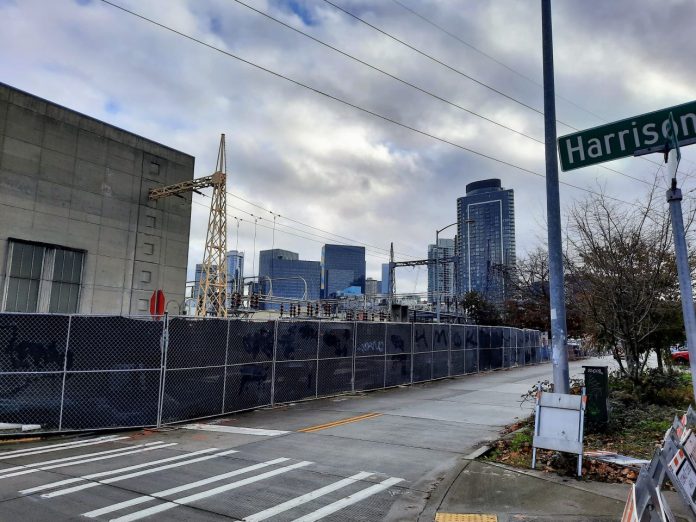
The business-backed campaign to relocate two planned light rail stations in Denny Triangle and in South Lake Union hit a setback as Sound Transit revealed last week lower ridership projections and a price tag of at least a half-billion dollars to pursue such an option.
On Thursday, the Sound Transit board received a breakdown of the implications of adding an additional two station locations into the mix as part of the options on the table in South Lake Union as part of the Ballard Link Extension project. Those last-minute changes were prompted by pushback from business groups over the traffic impacts of street closures in South Lake Union to build an underground station near Denny Way, who claimed their alternatives might be cheaper.
However, Sound Transit revealed estimates showing the new station pairing would add at least $500 million in additional project costs stemming from an additional 10 months of study, cost the system approximately 3,000 daily riders, and provide minimal overall gains, according to the presentation provided Thursday.
Shifting the location for a Denny station slightly to the west of the intersection of Denny Way and Westlake Avenue would reduce the need to close half of Westlake’s travel lanes, a closure that groups like the Seattle Metropolitan Chamber of Commerce, Vulcan, and Amazon are arguing would be devastating to the South Lake Union neighborhood, despite the relatively low volumes of vehicle traffic that the street sees compared to other nearby arterials. Those same groups are also supporting the new location for South Lake Union’s station at 5th Avenue N and Harrison Street, three blocks west of the agency’s current preferred station location at 7th Avenue N and Harrison.
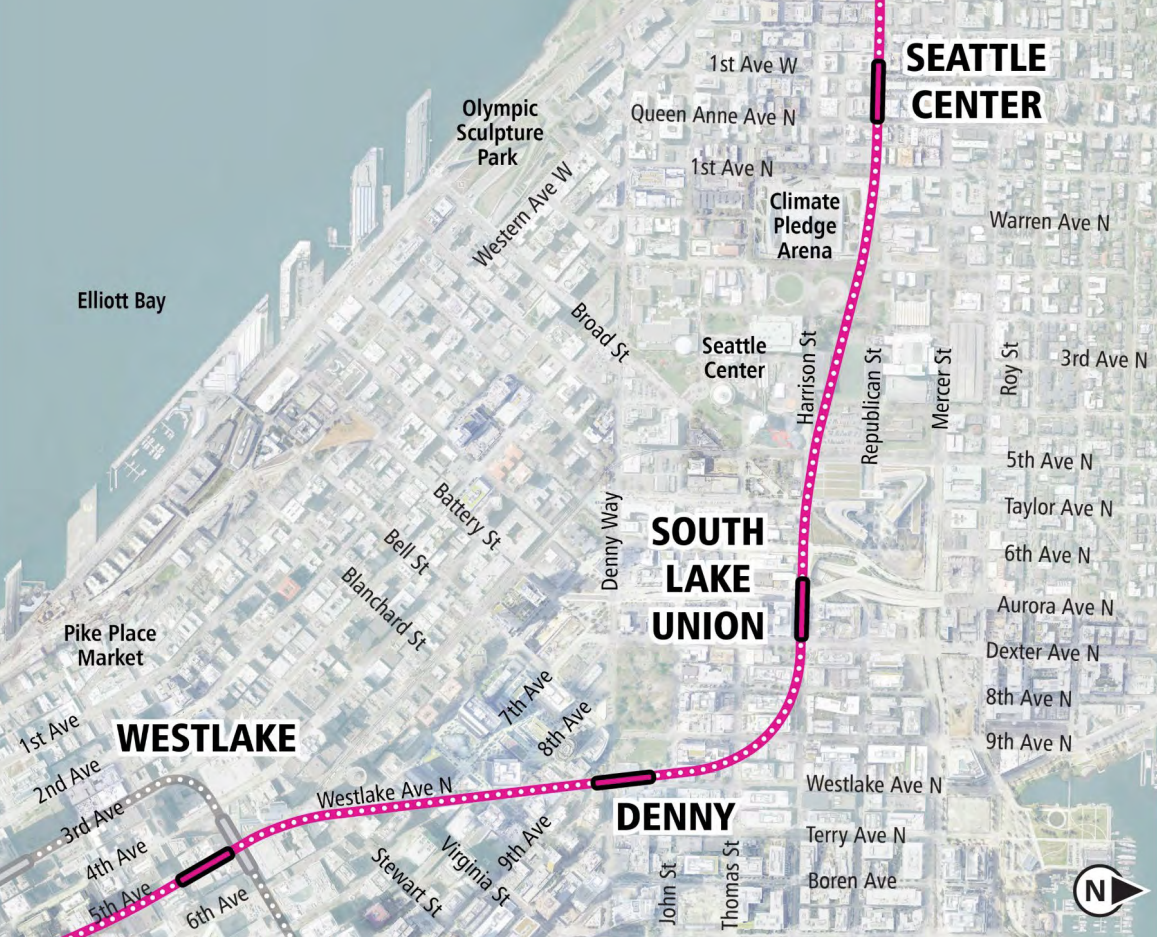
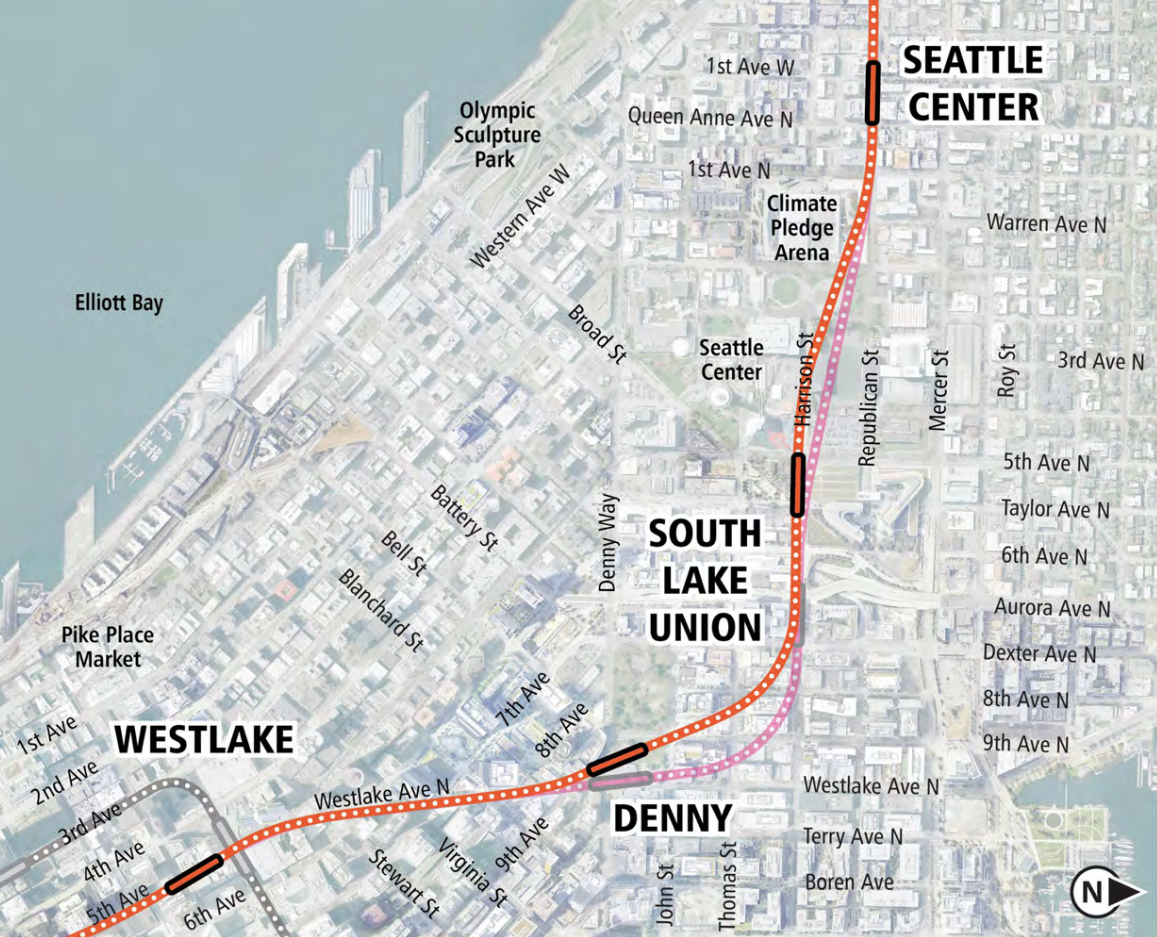
A new online petition created by the Chamber asks respondents to sign up to “Save South Lake Union” without mentioning the additional costs that Sound Transit would be asked to bear to study its new alternatives, nor does it mention the potential impacts to riders who would see longer transfers. Meanwhile Sound Transit has an online survey asking for feedback on the options it’s looking at in the area through May 7.
A 5th Avenue N station, across the street from Seattle Center, would lengthen travel times for riders connecting to and from north-south buses and cause around 3,000 potential riders to give up on Link, Sound Transit planners told the board, a total that amounts to 2% of average daily riders in 2042.
But the business groups argue that a 5th Avenue station would avoid costly relocation of utilities, a challenge that Sound Transit planners have acknowledged but not fully quantified in terms of potential costs. At this point, the two station pairs being considered are assumed to have roughly equal construction costs. But if the board adds this couplet into the mix only to later select it as the agency’s preferred alternative, the cost in delay could total a full billion dollars in inflation due to lost time.
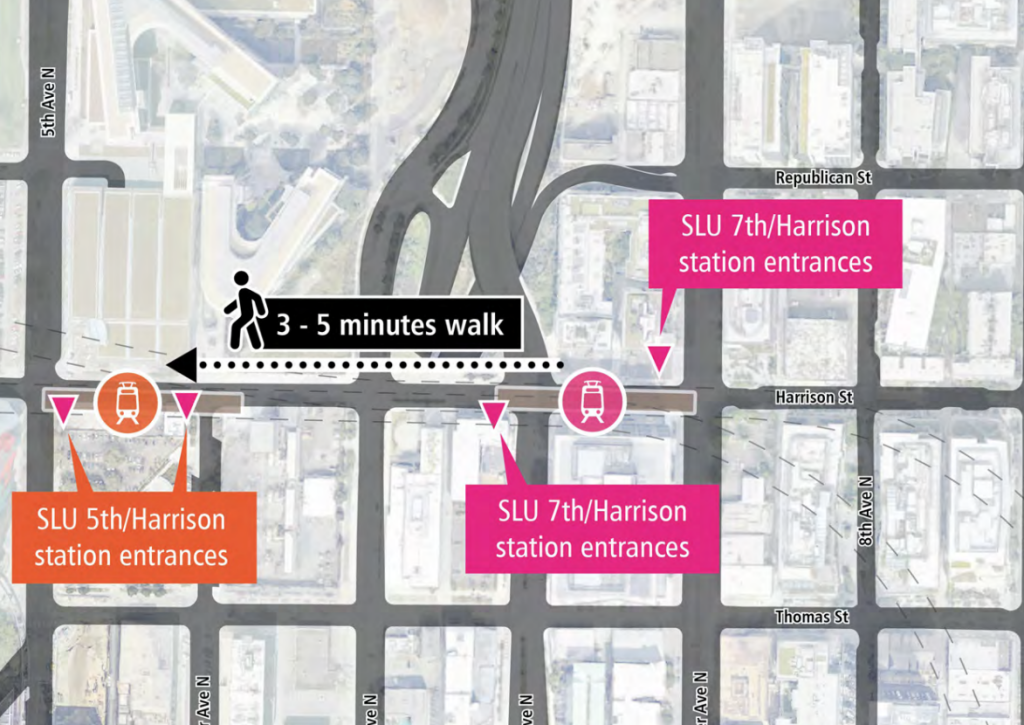
As for the Westlake Avenue closure at the heart of the debate? That would only last around two years at the start of station construction, Sound Transit staff said, with the street fully open to traffic for years three to seven (on decking over the station pit) with another partial closure in the final year of work. The partial closures would actually maintain the existing two through vehicle lanes that exist now on the street, with the two transit-only lanes (where turning vehicles are allowed) subsumed by construction. The South Lake Union Streetcar, however, wouldn’t be able to run on the stretch through the entirety of the construction period.

In all, selecting the new alternative couplet would avoid those Westlake closures, as well as most closures on nearby Denny Way, while shifting the impacts further north from 7th Avenue N onto 5th Avenue N, which would see a partial closure for the full duration of station construction, approximately eight years. A chart shown to the board Thursday breaks down the differences in anticipated roadway closures, illustrating the minimal gains that would come from adding the new options into the mix.
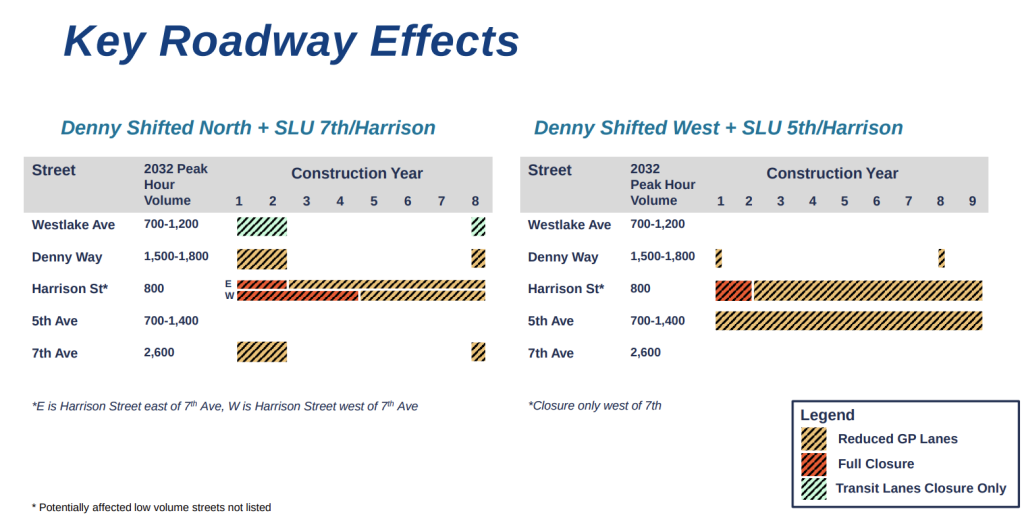
This debate represents much more than a discussion over two stations: a potential board vote next month to stay on track or veer off course will signal whether the way Sound Transit is handling delivery of its biggest capital projects is improving, with more deference to the expertise of staff with technical knowledge, or whether board decisions will continue to be swayed by political machinations.
Sound Transit’s technical advisory group (TAG), a body created to manage cost increases and project timelines and co-chaired by former Bay Area Rapid Transit (BART) General Manager Grace Crunican, has been explicit about the need to minimize board micromanaging. And the clearly articulated cost of delay here, up to a full $1 billion dollars if the two stations are added to the mix but not immediately identified as the preferred option, is new, and puts the cost of additional board deliberation in sharp relief.
But Seattle’s two representatives to the Sound Transit board, Mayor Bruce Harrell and Councilmember Dan Strauss, both appear open to the request to study these additional options, even as groups representing constituencies elsewhere in the city push for the project to stay on track.
“Without the context of a formal environmental process, people in Pioneer Square and Chinatown International District spend time trying to define the best idiom to describe wasting time,” Kathleen Barry Johnson, the executive director of Historic South Downtown, a group that advocates for community preservation in those two neighborhoods, wrote to Sound Transit board members this week, in requesting that the agency move forward as soon as possible with completing its final environmental impact statement (FEIS) as part of Ballard Link as soon as possible. “Are we trading the price of delay for funding an excellent system that maximizes ridership for the next 100 years?”
“I have to tell you that, this Fifth Avenue [option] shows incredible promise, for a variety of reasons,” Mayor Harrell said Thursday, touting a “reimagining” of the Seattle Center campus, presumably referencing the City’s immanent redevelopment plans for the Seattle Public Schools-owned Memorial Stadium, that he suggested would attract riders and offset any projected reductions from moving the station.
Harrell also seemed to downplay the potential impact on riders at Thursday’s meeting, suggesting that riders coming from North Seattle are only heading downtown so the impact of transfers at Harrison Street isn’t impactful. “When we look at the reliance on the E Line, I still don’t fully understand why people would get off the bus to go downtown, even if they could gain two or three minutes or so,” he said.
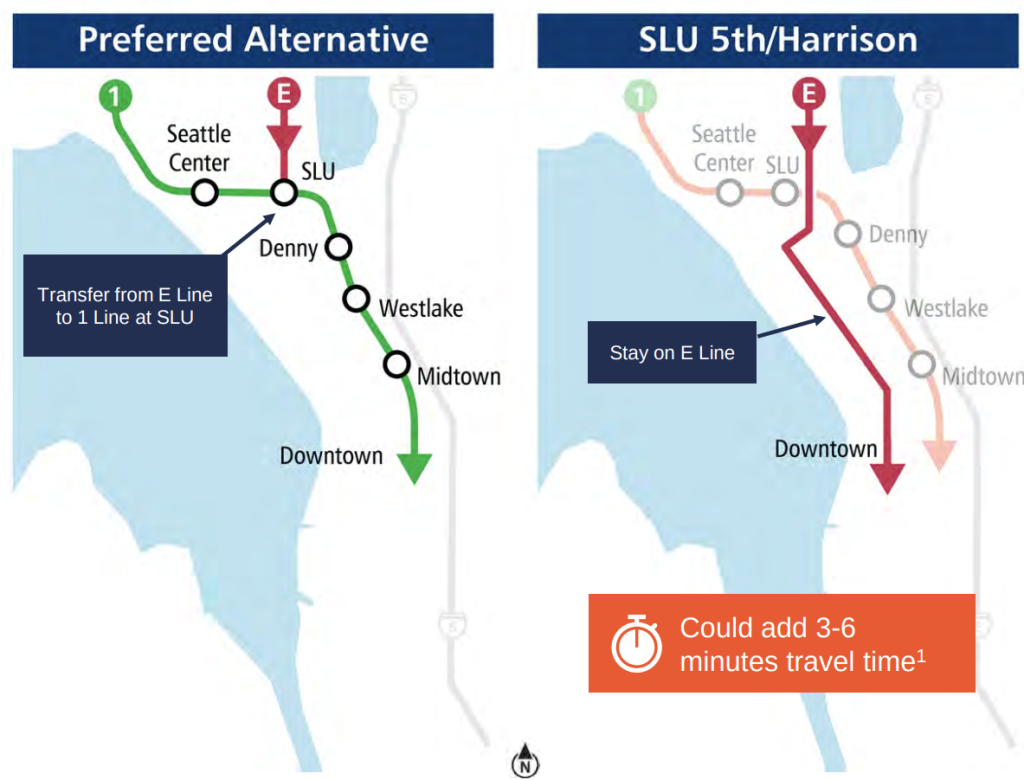
After Sound Transit’s system expansion committee cancelled a presentation on South Lake Union station options earlier this month because the analysis wasn’t quite ready, Amazon cried foul with process concerns, despite the fact that a formal board vote is weeks away and Sound Transit board members themselves are praising the depth of information provided to them in this new presentation. Amazon is apparently arguing that they should get a chance to influence how the Sound Transit board communicates with the agency’s own staff.
“Only 72 hours ago staff shared a new cost of delay estimate that lacks substantive detail and was released so quickly that there was no opportunity to vet or comment on the methodology before it was distributed to the board,” Amazon’s Jared Axelrod told the board Thursday. “We also believe that staff assigned an arbitrary cost to delay calculation which effectively guts consideration of the Fifth and Harrison Station option before it was even debated.”
South Lake Union advocates are far from united behind adding in these new alternatives. “The data does not disappoint: the option that delivers the greatest benefit to the community on-time and within budget is clear. It’s Westlake shifted north and Seventh and Harrison,” Julie Holland, president of the South Lake Union Community Council, told the board, calling the long term closure of 5th Avenue N a “significantly worse outcome.”

Councilmember Strauss, on his part, asked his fellow board members to withhold judgement until they had more info. “This information is under review, it’s not final, and I hope that we can refrain from basing our decisions on the information until we hear the final results of this review,” Strauss said.
Strauss also pushed the idea that some of the 10-month delay can be bought back by harnessing the power of the City of Seattle’s bureaucratic infrastructure to speed things up, a suggestion that didn’t seem to gain any traction with Sound Transit staff. Two Seattle mayoral administrations have promised similar streamlining and yet the delays have stacked up.
A board decision to delay Ballard Link yet again to study more station alternatives will not bode well for getting the agency’s house in order and would definitely signal that the recommendation of the TAG for board members to stay in their lane is not being taken to heart. Nor does it suggest that a greater commitment to regionalism from the board is actually taking root, despite some overtures early this year.
King County Councilmember and Sound Transit board member Claudia Balducci, in a conversation with The Urbanist last week about the lessons learned during the development of the Eastside’s 2 Line, offered her perspective on how the board should manage decisions like this.
“At a very high level, my takeaway has been, we really should, as an agency, put the stations where they make sense from a transit perspective, to the maximum extent possible, and then do our best to deal with the impacts of construction, [and] how they interact with the existing built environment,” Balducci said. “Because in every single line that I’ve been involved with planning, from the early days on, you do reach this point where the discussion of construction impacts just predominates over everything, because it’s right in your face, you’re facing several years of construction.”
Early on in the process, Sound Transit did not fully lay out the construction impacts of Ballard Link — which is admittedly a complex project through an extremely dense area — and what the agency is doing to mitigate them, and that has come back to bite them.
“I think we need to get better at talking about mitigation, and start being more effective at making decisions about station locations, and then sticking with them and working through the impacts,” Balducci said.
Ryan Packer has been writing for The Urbanist since 2015, and currently reports full-time as Contributing Editor. Their beats are transportation, land use, public space, traffic safety, and obscure community meetings. Packer has also reported for other regional outlets including BikePortland, Seattle Met, and PubliCola. They live in the Capitol Hill neighborhood of Seattle.

